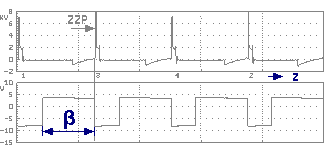|
|
 Dwell Angle Dwell Angle

Whereas the dwell angle was measured in distributor-shaft degrees, previously the contact breakers were closed as a switch in the primary circuit of the ignition coil. This is important, even without contact breakers,
because it determines the period of the electric charge. If the period is too short, not enough ignition energy is available, should it be too long, then the ignition coil can overheat and, should it be fused, then the fuse can
blow.
If the distributor shaft has the same number of cams as the engine has cylinders, and each cam has an opening- and closing angle, then the sum of the opening- and closing angles adds up to 360°. The closing angle is
always a percentage based on the amount of multiple cams that the engine has, thus, the sum of the opening- and closing angles. Therefore, in a four cylinder engine, an angle of 45° corresponds to a dwell-angle of 50%.
05/12
| 360° ·  % % |
= |
|
| 100 · z |
|
|  · 100 · z · 100 · z
|
% = |
|
| 360° |
|
| 360° ·  % % |
z = | |
| 100 ·  |
|
cartecc.com
Top of page
Index
2001-2014 Copyright programs, texts, animations, pictures: H. Huppertz - Email
Translator: Don Leslie -
Email: lesdon@t-online.de | |

|